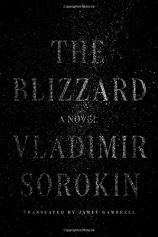The Blizzard
Review
The Blizzard
There are some unusual things about Vladimir Sorokin’s THE BLIZZARD. To start, it is told in one linear burst of 181 pages. It is chapterless, straightforward and cold. Aside from two short section breaks, the entirety of the story is told without pause. I can’t think of many other novels that have attempted this feat. I’ve considered some of the best --- Shirley Jackson’s WE HAVE ALWAYS LIVED IN THE CASTLE, Cormac McCarthy's CHILD OF GOD, Joseph Conrad’s HEART OF DARKNESS and Roberto Bolaño’s BY NIGHT IN CHILE --- almost all of which rhythmically tell their short tales with periodic breaks in pace. THE BLIZZARD does so only once, when it takes an out-there turn and briefly shifts the focus away from its two main characters.
Platon Ilich Garin, a district doctor, is trying to reach the village of Dolgoye in the Russian wilderness to deliver a vaccination that will help cure a zombie epidemic. However, a metaphysical but very real Russian blizzard is impeding his mission. Fortunately, he finds an old farmhand named Crouper (wait for the scene where he gathers 50 horses in the dead of night) to drive him in a sled-mobile. Along the way, though, the journey is repeatedly disrupted by the storm, along with wolves, giants and remarkable stops to small houses in the secluded Russian countryside. In one such instance, they meet a miller, a small man with a larger wife who provides an interesting turn and a nice dimension in this thin novel.
"The struggle of the doctor against the elements set in the Russian wilderness is a strong premise on its own, and moments ring with an earnest, homely quality."
While Sorokin has a knack for being subversive and seems to avoid contrivances, he adds some nice twists with the miller’s wife and the long stop with the Vitaminders. Garin and Crouper are well-rounded characters, but at times we lose the humanity of the expedition. Consider the only section break, where we’re taken through a figurative journey after the doctor presents a group of Vitaminders with a pyramid he found in the snow.
“At the same moment, a translucent half sphere enclosed the four at the table….the sphere was a zoogenous plastic so delicate that only the sound of it closing, reminiscent of an impossibly large soap bubble popping or the sleepy parting of a giant’s moist lips, betrayed his existence.” And the dream sequence goes on too long for its own good, especially in such a short novel, ending with the puzzling lines “Isled, Isled Isled…” eventually breaking down to “I-1, I-1, I-1…”. Experimental, yes, but an unnecessary detraction from a simple yet strong premise.
THE BLIZZARD is more concerned about people and the journey rather than the destination. So instead of getting into the specifics of the vaccination and who it’s for, the book focuses on the short span of time between Garin and Crouper, which works nicely. Strangely it is reminiscent of the much longer and deeper THE PLAGUE by Camus, which never had any zombies but shared a similar existential quality in its tone.
In THE PLAGUE, the struggle for rational meaning is set against a plague sweeping the Algerian city of Oran. Sorokin’s novel takes the same absurdist view, giving us scene after scene with no rational order, and in this way creating a sense of realism outside of any strict plot. Consider the search for Old Market and the fruitless attempts through the snow to find it. And much like THE PLAGUE, the point of view is of a village doctor. Both doctors are dealing with things beyond their control. While THE BLIZZARD takes us on a metaphysical journey, Camus’ work takes us into more existential grounding.
The struggle of the doctor against the elements set in the Russian wilderness is a strong premise on its own, and moments ring with an earnest, homely quality. Read it in a sitting or two during a heavy snowstorm. It more than serves readers well during these cold winter months.
Reviewed by Stephen Febick on January 8, 2016
The Blizzard
- Publication Date: December 1, 2015
- Genres: Fantasy, Fiction, Historical Fantasy, Historical Fiction
- Hardcover: 192 pages
- Publisher: Farrar, Straus and Giroux
- ISBN-10: 0374114374
- ISBN-13: 9780374114374





